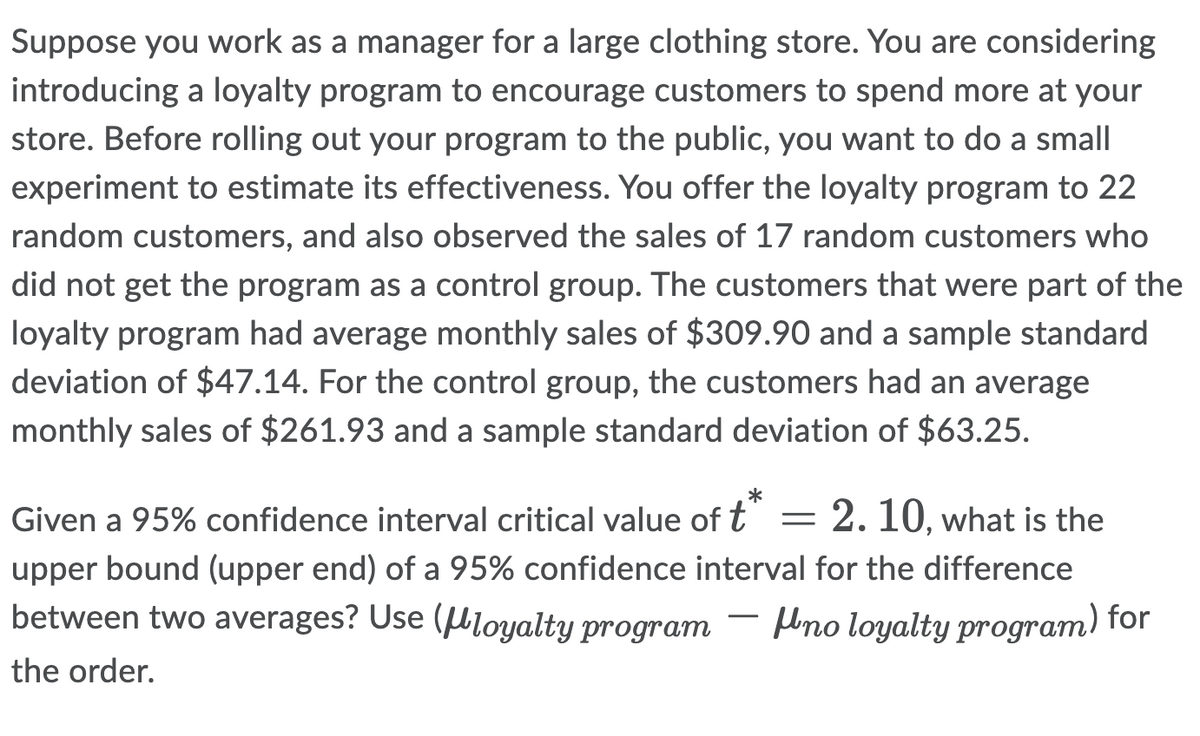Suppose you work as a manager for a large clothing store. You are considering introducing a loyalty program to encourage customers to spend more at your store. Before rolling out your program to the public, you want to do a small experiment to estimate its effectiveness. You offer the loyalty program to 22 random customers, and also observed the sales of 17 random customers who did not get the program as a control group. The customers that were part of the loyalty program had average monthly sales of $309.90 and a sample standard deviation of $47.14. For the control group, the customers had an average monthly sales of $261.93 and a sample standard deviation of $63.25. * Given a 95% confidence interval critical value of t = 2.10, what is the upper bound (upper end) of a 95% confidence interval for the difference between two averages? Use (loyalty program no loyalty program) for the order.
Suppose you work as a manager for a large clothing store. You are considering introducing a loyalty program to encourage customers to spend more at your store. Before rolling out your program to the public, you want to do a small experiment to estimate its effectiveness. You offer the loyalty program to 22 random customers, and also observed the sales of 17 random customers who did not get the program as a control group. The customers that were part of the loyalty program had average monthly sales of $309.90 and a sample standard deviation of $47.14. For the control group, the customers had an average monthly sales of $261.93 and a sample standard deviation of $63.25. * Given a 95% confidence interval critical value of t = 2.10, what is the upper bound (upper end) of a 95% confidence interval for the difference between two averages? Use (loyalty program no loyalty program) for the order.
Holt Mcdougal Larson Pre-algebra: Student Edition 2012
1st Edition
ISBN:9780547587776
Author:HOLT MCDOUGAL
Publisher:HOLT MCDOUGAL
Chapter11: Data Analysis And Probability
Section11.4: Collecting Data
Problem 6E
Related questions
Question

Transcribed Image Text:Suppose you work as a manager for a large clothing store. You are considering
introducing a loyalty program to encourage customers to spend more at your
store. Before rolling out your program to the public, you want to do a small
experiment to estimate its effectiveness. You offer the loyalty program to 22
random customers, and also observed the sales of 17 random customers who
did not get the program as a control group. The customers that were part of the
loyalty program had average monthly sales of $309.90 and a sample standard
deviation of $47.14. For the control group, the customers had an average
monthly sales of $261.93 and a sample standard deviation of $63.25.
Given a 95% confidence interval critical value of t* = 2. 10, what is the
upper bound (upper end) of a 95% confidence interval for the difference
between two averages? Use (μloyalty program
Hno loyalty program) for
the order.
Expert Solution
This question has been solved!
Explore an expertly crafted, step-by-step solution for a thorough understanding of key concepts.
Step by step
Solved in 2 steps with 2 images

Recommended textbooks for you

Holt Mcdougal Larson Pre-algebra: Student Edition…
Algebra
ISBN:
9780547587776
Author:
HOLT MCDOUGAL
Publisher:
HOLT MCDOUGAL

College Algebra (MindTap Course List)
Algebra
ISBN:
9781305652231
Author:
R. David Gustafson, Jeff Hughes
Publisher:
Cengage Learning

Glencoe Algebra 1, Student Edition, 9780079039897…
Algebra
ISBN:
9780079039897
Author:
Carter
Publisher:
McGraw Hill

Holt Mcdougal Larson Pre-algebra: Student Edition…
Algebra
ISBN:
9780547587776
Author:
HOLT MCDOUGAL
Publisher:
HOLT MCDOUGAL

College Algebra (MindTap Course List)
Algebra
ISBN:
9781305652231
Author:
R. David Gustafson, Jeff Hughes
Publisher:
Cengage Learning

Glencoe Algebra 1, Student Edition, 9780079039897…
Algebra
ISBN:
9780079039897
Author:
Carter
Publisher:
McGraw Hill
